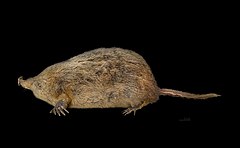Gwiazdonosy
| Condylurini | |||
| Gill, 1875[1] | |||
 Przedstawiciel rodzaju – gwiazdonos amerykański (C. cristata) | |||
| Systematyka | |||
| Domena | |||
|---|---|---|---|
| Królestwo | |||
| Typ | |||
| Podtyp | |||
| Gromada | |||
| Podgromada | |||
| Rząd | |||
| Podrząd | |||
| Rodzina | |||
| Podrodzina | |||
| Plemię |
gwiazdonosy | ||
| Typ nomenklatoryczny | |||
|
Plemienia: Condylura Illiger, 1811 | |||
| Synonimy | |||
| |||
| Rodzaje i gatunki | |||
| |||
Gwiazdonosy[10] (Condylurini) – monotypowe plemię ssaków z podrodziny grzebaczy (Scalopinae) w obrębie rodziny kretowatych (Talpidae).
Zasięg występowania
[edytuj | edytuj kod]Plemię obejmuje jeden żyjący współcześnie gatunek występujący w Ameryce Północnej[11][12].
Morfologia
[edytuj | edytuj kod]Długość ciała (bez ogona) 96–128 mm, długość ogona 65–83,5 mm; masa ciała 27–52 g[13][14].
Systematyka
[edytuj | edytuj kod]Do plemienia Condylurini należy jeden rodzaj, Condylura, który zdefiniował w 1811 roku niemiecki zoolog Johann Karl Wilhelm Illiger w publikacji swojego autorstwa o tytule Prodromus systematis mammalium et avium[9]. Illiger wymienił dwa gatunki – Sorex cristatus Linnaeus, 1758 i Talpa longicaudata Erxleben, 1777 (= Scalops breweri Bachman, 1841) – z których gatunkiem typowym jest Sorex cristatus Linnaeus, 1758 (gwiazdonos amerykański).
Etymologia
[edytuj | edytuj kod]- Condylura: gr. κονδυλος kondulos ‘guzek’; ουρα oura ‘ogon’[15].
- Talpasorex: zbitka wyrazowa nazw rodzajów: Talpa Linnaeus, 1758 (kret) oraz Sorex Linnaeus, 1758 (ryjówka)[16]. Gatunek typowy (oznaczenie monotypowe): Sorex cristatus Linnaeus, 1758.
- Astromycter (Astromyctes, Astromydes): gr. αστηρ astēr, αστερος asteros ‘gwiazda’; μυκτηρ muktēr, μυκτηρος muktēros ‘nos’, od μυσσομαι mussomai ‘wydmuchać nos’[17]. Gatunek typowy (oznaczenie monotypowe): Astromycter prasinatus Harris, 1825 (= Sorex cristatus Linnaeus, 1758).
- Rhinaster: gr. ῥις rhis, ῥινος rhinos ‘nos, pysk’; αστηρ astēr, αστερος asteros ‘gwiazda’[18].
Podział systematyczny
[edytuj | edytuj kod]Do plemienia należy jeden rodzaj gwiazdonos[10] (Condylura) z jednym występującym współcześnie gatunkiem[19][14][11][10]:
- Condylura cristata (Linnaeus, 1758) – gwiazdonos amerykański
Opisano również gatunki wymarłe z pliocenu dzisiejszej Polski[20]:
- Condylura izabellae Skoczeń, 1976[21]
- Condylura kowalskii Skoczeń, 1976[22]
Uwagi
[edytuj | edytuj kod]- ↑ Nowa nazwa dla Condylura Illiger, 1811.
- ↑ Wariant pisowni Astromycter T.M. Harris, 1825.
- ↑ Niepoprawna późniejsza pisownia Astromycter T.M. Harris, 1825.
Przypisy
[edytuj | edytuj kod]- ↑ a b T.N. Gill. Synopsis of Insectivorous Mammals. „Bulletin of the United States Geological and Geographical Survey of the Territories”. 1 (2), s. 110, 1875. (ang.).
- ↑ É.L. Trouessart. Synopsis sytematicus et geographicus mammalium. „Revue et magasin de zoologie pure et appliquée”. 3e série. 7, s. 269, 1879. (fr.).
- ↑ O. Thomas. On a Collection of Small Mammals from the Tsin-ling Mountains, Central China, presented by Mr.G. Fenwick Owen to the National Museum. „The Annals and Magazine of Natural History”. Eighth series. 10 (58), s. 397, 1912. (ang.).
- ↑ H.R. Schinz: Das Thierreich, eingetheilt nach dem Bau der Thiere als Grundlage ihrer Naturgeschichte und der vergleichenden Anatomie von den Herrn Ritter von Cuvier. Cz. 1: Säugethiere und Vögel. Stuttgart und Tübingen: in der J.G. Cotta’schen Buchhandlung, 1821, s. 191. (niem.).
- ↑ J.O. Balch (red.). The strange animal. „Eastern Star and Washington Advertiser”. 2, s. nienumerowane, 1825. (ang.).
- ↑ J.G. Wagler: Natürliches System der Amphibien, mit vorangehender Classification der Säugethiere und Vögel. Ein Beitrag zur vergleichenden Zoologie. München, Stuttgart und Tübingen: In der J.G. Cotta’scchen Buchhandlung, 1830, s. 14. (niem.).
- ↑ J.E. Gray: List of the specimens of Mammalia in the collection of the British museum. London: The Trustees, 1843, s. xxi, 76. (ang.).
- ↑ E. Blyth: Catalogue of the Mammalia in the Museum Asiatic Society. Calcutta: Savielle & Cranenburgh, 1863, s. 87. (ang.).
- ↑ a b J.K.W. Illiger: Prodromus systematis mammalium et avium: additis terminis zoographicis utriusque classis, eorumque versione germanica. Berolini: Sumptibus C. Salfeld, 1811, s. 125. (łac.).
- ↑ a b c d Nazwy zwyczajowe za: W. Cichocki, A. Ważna, J. Cichocki, E. Rajska-Jurgiel, A. Jasiński & W. Bogdanowicz: Polskie nazewnictwo ssaków świata. Warszawa: Muzeum i Instytut Zoologii PAN, 2015, s. 75. ISBN 978-83-88147-15-9. (pol. • ang.).
- ↑ a b C.J. Burgin, D.E. Wilson, R.A. Mittermeier, A.B. Rylands, T.E. Lacher & W. Sechrest: Illustrated Checklist of the Mammals of the World. Cz. 2: Eulipotyphla to Carnivora. Barcelona: Lynx Edicions, 2020, s. 80. ISBN 978-84-16728-35-0. (ang.).
- ↑ D.E. Wilson & D.M. Reeder (redaktorzy): Genus Condylura. [w:] Mammal Species of the World. A Taxonomic and Geographic Reference (Wyd. 3) [on-line]. Johns Hopkins University Press, 2005. [dostęp 2023-01-27].
- ↑ B. Kryštufek & M. Motokawa: Family Talpidae (Moles, Desmans, Star-nosed Moles and Shrew Moles). W: R.A. Mittermeier & D.E. Wilson (redaktorzy): Handbook of the Mammals of the World. Cz. 8: Insectivores, Sloths and Colugos. Barcelona: Lynx Edicions, 2018, s. 603. ISBN 978-84-16728-08-4. (ang.).
- ↑ a b Class Mammalia. W: Lynx Nature Books: All the Mammals of the World. Barcelona: Lynx Edicions, 2023, s. 444. ISBN 978-84-16728-66-4. (ang.).
- ↑ Palmer 1904 ↓, s. 198.
- ↑ Palmer 1904 ↓, s. 660.
- ↑ Palmer 1904 ↓, s. 126.
- ↑ Palmer 1904 ↓, s. 604.
- ↑ N. Upham, C. Burgin, J. Widness, M. Becker, C. Parker, S. Liphardt, I. Rochon & D. Huckaby: Treeview of Mammalian Taxonomy Hierarchy. [w:] ASM Mammal Diversity Database (Version 1.11) [on-line]. American Society of Mammalogists. [dostęp 2023-10-25]. (ang.).
- ↑ J.S. Zijlstra, Condylura Illiger, 1811, Hesperomys project (Version 23.8.1), DOI: 10.5281/zenodo.7654755 [dostęp 2023-10-25] (ang.).
- ↑ Skoczeń 1976 ↓, s. 305.
- ↑ Skoczeń 1976 ↓, s. 295.
Bibliografia
[edytuj | edytuj kod]- T.S. Palmer. Index Generum Mammalium: a List of the Genera and Families of Mammals. „North American Fauna”. 23, s. 1–984, 1904. (ang.).
- S. Skoczeń. Condylurini Dobson, 1883 (Insectivora, Mammalia) in the Pliocene of Poland. „Acta Zoologica Cracoviensia”. 21 (8), s. 291–313, 1976. (ang.).
